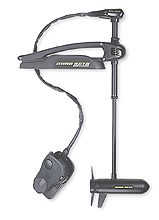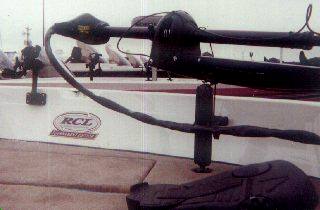 












Promotional
Team Favorites
Lodging food and more







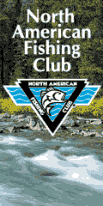

|
Rigging Tournament-Tough
By JOHN KOLINSKI
Editor's note: John Kolinski is the reigning 2002 Professional Walleye
Trail Angler of the Year, as well as an 11-time championship qualifier
during eight years of professional fishing on the PWT, RCL and MWC.
His
articles appear in numerous outdoor publications and at several web
sites. Kolinski is sponsored by Triton Boats, Mercury Motors, MinnKota,
Lowrance Electronics, Normark/Storm Lures, Flambeau, Off-Shore Tackle,
Berkley Trilene and Tempress Rod Holders.
In some ways, rigging a boat is like marriage. Get it right, and there
will be many enjoyable and focused days ahead. Get it wrong, and
there will be conflict and breakdowns. Reliability, compatibility
and trustworthiness are characteristics any avid angler appreciates
whether it's at home or on the water. And when it comes to boats,
rigging can make that difference.
Tournament anglers are probably as adept at rigging as anyone. Our
livelihood depends on our equipment. Most of us also have plenty of
rigging experience to draw upon since we trade boats every year or two.
There are plenty of considerations when setting up a boat, from wiring
accessories and securing bow-mount trolling motors to the placement of
rod holders and GPS antenna modules. Big-water anglers have the additional
issues that go with rough water. Many a day of fishing has been lost
because of broken kicker motor brackets, busted up bow-mounts and
poorly secured GPS or sonar units.
The best place to start rigging is from a seat inside the boat.
Visualize where things should go to provide accessibility, fishability
and protection from the elements.
Here's a primer based on my experience rigging the Triton 205s I run
on
the Professional Walleye Trail:
Bow-mount trolling motors
Most boats today are equipped with the bow-mount of the consumer's
choice. Therefore, there are no concerns about mounting or wiring those
units. However, most bow-mounts are not designed to handle the beating
they take over rough water.
All that is required to secure my MinnKota model is a RAM stabilizer bar
that supports the shaft. Cinch straps are also available and work well
on many models.
Mounting electronics
This is an important consideration for two reasons. GPS and sonar units
need to be accessible while the boat is under power and visible while
fishing, but not in the way. Most anglers prefer to place them on the
dash. One of the most critical decisions to be made here is the type of
mounting system. I've tried several over the years. Some don't hold the
units in place when it's bumpy. Others have a tendency to loosen up in
rough water and tilt to the side. I haven't had any of those problems with
Ultra Mounts.When attaching the Ultra Mounts to the boat, I drill holes
that are no more than 1/32nd-inch smaller than the screws. Then I use a
chamfering tool to smooth and bevel the holes to the same depth as the
fiberglass. Holes that are too small and aren't beveled correctly are a
major cause of cracks. Fill the holes or cover the screws with silicone
before attaching the
mounts and they'll never come loose. Quality marine radios are generally
waterproof, but it still makes sense to mount them under the dash
in a protected area where they won't be exposed in a downpour or in the
way while you are fishing. Since they are typically used only sparingly
or in case of emergency, convenience isn't the primary consideration. Place
the antenna somewhere along the gunwale in the front half of the boat where
it won't get in the way.
It's particularly prudent to mount the microphone/transmitter somewhere
dry and secure. A faulty mike is not a good problem to have when you
are
broken down eight miles offshore and need help. Another important consideration
is locating the module for the GPS unit. If it is obstructed in any
way, it may not be able to connect with enough satellites to provide
the data you need. That's one reason some anglers complain that their
GPS struggles to show changes inlocation at extremely slow speeds.
Don't put the module too close to the windshield. If you run a kicker
motor from the back of the boat, place it on the other side of the
boat
where you won't create an obstruction.
Wiring accessories
Some boats are built with extra terminals on the fuse block for wiring
items such as GPS, sonar and marine radios. In that case, it's just a
matter of deciding exactly where to locate those units and then running
the power cords to the fuse block. Many boats don't provide extra electrical
ports. In that case, I wire accessories invididually to the boat's
main cranking battery, using a fish tape to pull the wiring through
the boat's cavity.Each accessory is wired individually to prevent interference
and to ensure a consistent flow of power. Each wire includes an in-line
fuse. If I ever have a problem, it's easier to pinpoint when electronics
are wired separately.
Transducers
Manufacturers of fiberglass boats can mold a puck-style transducer
right into the hull, and the performance is generally good. Otherwise,
they need to be mounted on the transom, and location is critical
to accurate information at a variety of speeds. Read the owner's
manual that comes with the sonar unit and locate the transducer according
to the manufacturer's instructions. It needs to remain in the water
when you are on plane, yet not draw too much water and kick up at high
speeds.
I mount transducers directly to the transom, using the same procedure
I use to attach other accessories. Drill holes 1/32nd-inch smaller
than the screws, use the chamfer tool on each hole and fill them
with silicone to seal everything.
Rod holders
I mount my Tempress rod holders directly to the fiberglass along the
gunwale of the boat. Some models feature rails along the gunwale at the
stern of the boat where rod holders can also be mounted. If possible, choose
locations where rod holders won't interfere with access to compartments
such as baitwells and livewells, but still provide enough separation to
fish multiple rods. Mount the brackets along the inside of the gunwale
to prevent snagging lines and nets on
them when they are not in use. Again, drill holes that are no more
than 1/32nd-inch smaller than the screws, use the chamfer tool on
each hole and coat the screws with silicone before securing the brackets
in place.
Batteries
I always make certain the Optima batteries I use in my Triton are
well-secured within their storage compartment. Most boats are set up
with brackets or strapping systems to keep them from bouncing or banging
around under power.
If your boat doesn't come with a three-bank battery charger, install
one. It's the best way to make sure the deep-cycle trolling batteries
are equally recharged after use. Since I wire additional accessories
directly to the cranking battery, I use a separate charger to restore it
at the end of the day.
Kicker motors
There are two ways to go here. Over the course of my tournament career,
I've seen several kickers lost in rough water because of the pounding
they take. Direct-mounted kickers can also cause serious damage to
the
transom.
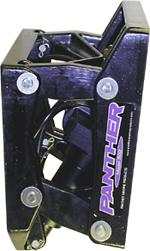
Panther
300
Jackplate |
A Panther Marine electric lift is a wise investment that makes it
convenient to lift and lower the kicker while also helping it ride
more securely. If a kicker motor and lift aren't in the budget, consider
the Panther Navigator electric trolling motor. It's a 24-volt unit
with 55 pounds of thrust that attaches atop the trim fin on the big
motor. When the boat is on plane, the Navigator is out of the water
and out of harm's way. |
Jackplates
In my opinion, the new Panther 450 electric jackplate is another solid
investment. Not only does it help an angler get a bit more performance
out of the main engine, it also allows me to take my Triton into
shallower water than most boats will go because of the additional trim
and tilt control it provides.
Fire extinguishers
One of the final things I do is mount at least one fire extinguisher
somewhere near the driver's compartment for easy access. It's not a bad
idea to locate another under the dash on the passenger side if you are
running a dual-console boat. Don't make the mistake of putting extinguishers
in places that are difficult to get at. It could cost you your life.
Finishing touches
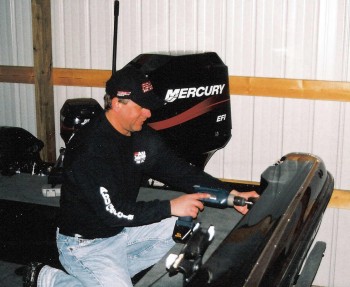 |
Once I've got everything in place, I work my way around the boat and
secure any exposed wiring or fuel lines. If you have added a fuel line
for the kicker motor, make sure it isn't in an area where it can get
pinched. It's a good idea to enclose the fuel line inside a sleeve. |
I use small tie straps to connect any loose wires to the steering cable
and keep them out of the splash tray where they can become tangled with
hooks, fish or other wires and cables. Again, it's a good idea to use a
sleeve to protect any wiring in this area.
You only get one shot at rigging a new boat. Do it right, and you'll
be
in for years of worry-free operation and performance. Do it wrong and
it
may nag you for years. What's worse, you might not be able to get rid
of
it.
E-mail
John Kolinski

Fish
Clix Banner Exchange
Walleyes Inc. website is maintained
by Randy
Tyler Fishing the In-Fisherman Professional Walleye Circuit, Masters
Walleye Circuit and the Wal Mart RCL Circuit. All rights reserved.Copyright
1999/2003
Please visit these site sponsors
Daiichi/Tru-Turn Hooks,
Lindy
Little Joe,
R-A.M Mounting Systems,
Ranger
boats, Mercury Outboards,Bedford
Sales , Church Tackle, Panther
Marine Products,
Webfoots body sock,
Bait
Rigs Tackle ,Dual Pro Charging Systems,
Daiwa
Rods and Reels,
Driftcontrol
Wind socks,
Trojan Batteries
|


